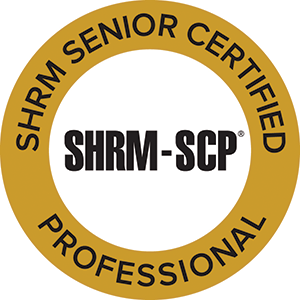When your organization reaches 50 or more employees there are some additional federal, state and local laws you need to start following to ensure you are in compliance. Here are two important areas of compliance that affect employers with 50 or more employees.
Harassment Prevention Training
Since 2005 employers with 50 or more full-time, part-time, and temporary employees or independent contractors have been required to provide supervisory employees with two hours of sexual harassment prevention training within six months of hire or promotion, and once every two years thereafter.
Under recently passed legislation, employers with five or more employees are now required to provide anti-harassment training to all employees – both supervisors and non-supervisors – every two years. California SB 1343 requires that all employees be trained by the end of 2019. Training for non-supervisors must be at least one hour. Training for supervisors must be two hours.
Family and Medical Leave Act (FMLA)
The Family and Medical Leave Act (FMLA) is a federal law that requires covered employers to grant an eligible employee up to a total of 12 work weeks of unpaid leave during any 12-month period for one or more of the following reasons:
- For the birth and care of the newborn child of the employee;
- For placement with the employee of a son or daughter for adoption or foster care;
- To care for an immediate family member (spouse, child, or parent) with a serious health condition; or
- To take medical leave when the employee is unable to work because of a serious health condition.
Companies fall under FMLA when they have 50 or more employees in any (not just consecutive) 20 calendar weeks of the current or preceding year.
Eligibility
Employees who satisfy certain criteria are eligible for Family or Medical Leave of up to 12 weeks during each rolling 12-month period in accordance with applicable law. Employees eligible for Family and Medical Leave are those who:
- Have completed 12 months of employment with their employer;
- Have worked at least 1,250 hours for their employer during the previous 12 months; and
- Work in a facility with at least 50 employees or in a facility where there are at least 50 employees within 75 surface miles. Employees with no fixed work site will be considered to work from the site to which they report, or the site from which their work is assigned, or the site designated as their home base.
NOTE: Companies must continue the same health plans in which the employee was enrolled before the first day of the leave at the same level and under the same conditions of coverage as if they had remained an active employee for the lesser of the duration of such leave or 12 work weeks.
California Family Rights Act (CFRA)
The California Family Rights Act (CFRA) is very similar to FMLA and applies to employers in California. CFRA allows eligible employees to take up to 12 weeks of unpaid job-protected leave during a 12-month period.
CFRA covers private employers with 50 or more workers within 75 miles of the worksite, and public employers with any number of workers. CFRA runs concurrently with FMLA.
CFRA was enacted to provide employees with work leave rights for reasons such as:
- Birth of a child.
- Placement of the employee’s child through adoption or in a foster care home.
- A serious health condition incurred by the worker’s spouse, child, or parent.
- The employee is unable to work because of a serious health condition.
Eligibility
Employee eligibility for CFRA is similar to FMLA. For both CFRA and FMLA, time off for sick leave, vacation/annual leave, administrative time off (ATO), compensating time off (CTO), holidays, informal time off (ITO) or personal leave (PL) are not to be counted toward the 1,250 hours of work.
Training Leave for Emergency Rescue Personnel
Employers with 50 or more people must allow temporary leaves of absence — up to a total of 14 days per calendar year—for employees who are volunteer firefighters, reserve peace officers and emergency personnel to engage in fire, law enforcement or emergency rescue training.
You cannot terminate, threaten with termination, demote, suspend or otherwise discriminate against an employee who takes time off to engage in fire or law enforcement training. An employee who suffers any of these consequences is entitled to reinstatement and reimbursement for lost wages and work benefits. The employee can file a claim with the Division of Labor Standards Enforcement (DLSE).
San Francisco Paid Parental Leave
This San Francisco ordinance requires employers with 50 or more employees to supplement California’s Paid Family Leave (PFL) for employees working in the city. The purpose is to allow employees to receive 100% of their gross weekly wages while on a parental leave of absence. PFL currently provides eligible employees with up to 55% of their regular wages. Employees may receive these benefits for up to six weeks in a 12-month period. San Francisco’s law requires covered employers to provide additional wage replacement benefits of up to 45% of the employee’s wages, subject to the weekly maximum.
Please contact me at michelle@connecttohr.com for more information about what you need to consider as a business with 50 or more employees.




 Unless you’ve been avoiding the news over the past year, you’ve probably noticed that the national conversation – and in many cases behavior – has become increasingly negative. From the White House’s terse Tweets, to a growing number of hate crimes, to the now-famous memo that stoked the fires of gender bias, respect, empathy and good manners seem to have gone out the window.
Unless you’ve been avoiding the news over the past year, you’ve probably noticed that the national conversation – and in many cases behavior – has become increasingly negative. From the White House’s terse Tweets, to a growing number of hate crimes, to the now-famous memo that stoked the fires of gender bias, respect, empathy and good manners seem to have gone out the window. You only have to glance at the news to get the feeling that workplace bullying and harassment are on the rise. Bill O’Reilly was called out recently for his behavior toward women at Fox News, as Roger Ailes had been accused before him. As of a few days ago, more than 50 companies had pulled their advertising dollars from The O’Reilly Factor.
You only have to glance at the news to get the feeling that workplace bullying and harassment are on the rise. Bill O’Reilly was called out recently for his behavior toward women at Fox News, as Roger Ailes had been accused before him. As of a few days ago, more than 50 companies had pulled their advertising dollars from The O’Reilly Factor.
